Lop County
Lop County[6][7][8][9][10] (ⓘ,[11] Uyghur: لوپ ناھىيىسى), also Luopu[12][13] (from Mandarin Chinese), is a county in Hotan Prefecture, in the southwest of the Xinjiang Uyghur Autonomous Region, China. Almost all the residents of the county are Uyghur and live around oases situated between the desolate Taklamakan Desert and Kunlun Mountains. The county is bordered to the north by Aksu and Awat County in Aksu Prefecture,[1] to the east by Qira/Chira County, to the northwest by Karakax County, to the west by Hotan (Khotan) and to the south and west by Hotan County.
Lop County
Luopu, Lo-p'u | |
|---|---|
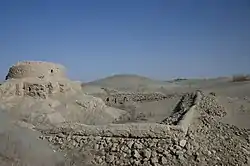 Rawak Stupa in the Taklamakan Desert | |
.png.webp) Location of Lop County (red) within Hotan Prefecture (yellow) and Xinjiang | |
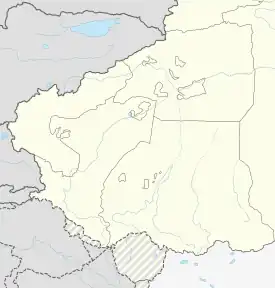 Lop Location of the seat in Xinjiang 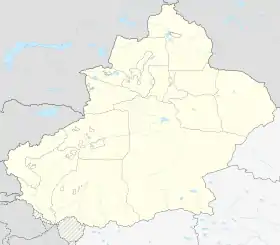 Lop Lop (Xinjiang) 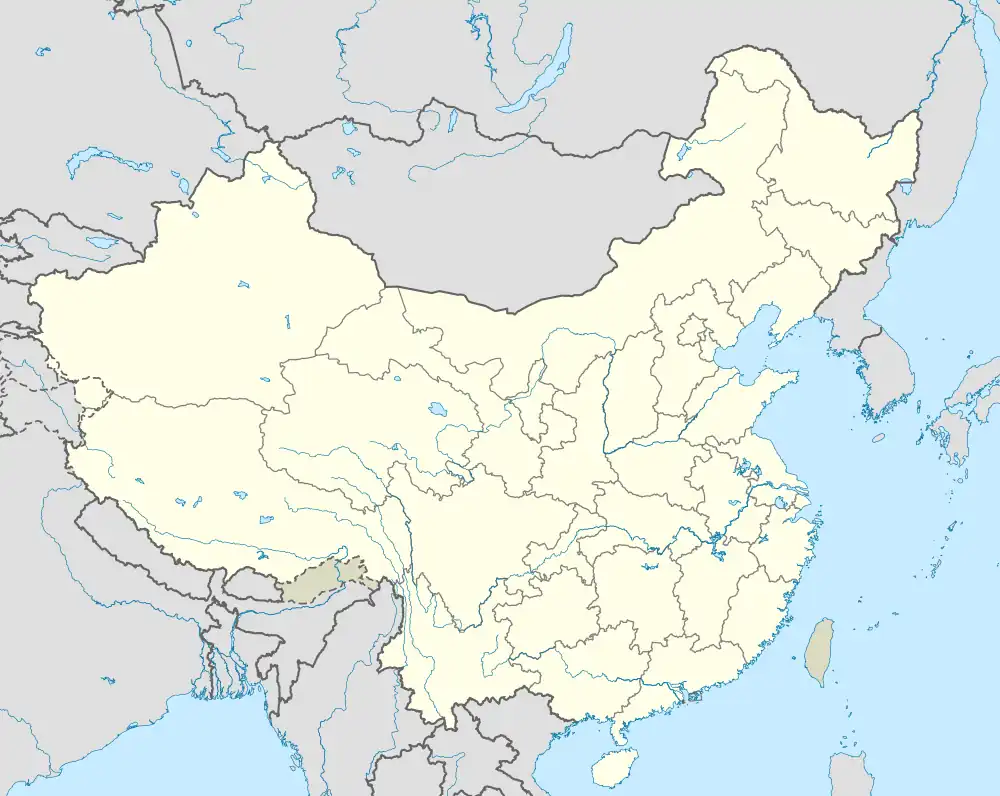 Lop Lop (China) | |
| Coordinates: 37.074°N 80.189°E | |
| Country | China |
| Autonomous region | Xinjiang |
| Prefecture | Hotan |
| County seat | Lop Town |
| Area | |
| • Total | 14,287 km2 (5,516 sq mi) |
| Population (2020)[4] | |
| • Total | 286,900 |
| • Density | 20/km2 (52/sq mi) |
| Ethnic groups | |
| • Major ethnic groups | Uyghur[2][5] |
| Time zone | UTC+8 (China Standard[lower-alpha 1]) |
| Postal code | 848200 |
| Website | www |
| Lop County | |||||||||||
|---|---|---|---|---|---|---|---|---|---|---|---|
| Uyghur name | |||||||||||
| Uyghur | لوپ ناھىيىسى | ||||||||||
| |||||||||||
| Chinese name | |||||||||||
| Simplified Chinese | 洛浦县 | ||||||||||
| Traditional Chinese | 洛浦縣 | ||||||||||
| |||||||||||
History
Local inhabitants at Sampul cemetery (Shanpula; سامپۇل / 山普拉) around 14 km (8.7 mi)[14] where art such as the Sampul tapestry has been found,[15] buried their dead from roughly 217 BCE to 283 CE.[16] The analysis of mtDNA haplogroup distribution showed that the Sampula inhabitants had a large mixture of East Asian, West-Asian and European characteristics.[14][17] According to Chengzhi et al. (2007), analysis of maternal mitochondrial DNA of the human remains has revealed genetic affinities at the maternal side to Ossetians and Iranians, an Eastern-Mediterranean paternal lineage.[14][18][note 1]
Archaeologist Aurel Stein visited Rawak Stupa during his First Central Asian expedition in April 1901.[25]
Lop County was established in August 1902.[2][26]
In May 1956, Abdimit, a Sufi shaykh from Khotan, attempted to incite insurrection in the county which was put down by armed troops and police forces.[27][28]
The Sampul tapestry was discovered in Sampul in the mid-1980s.
Between August 1986 and May 1987, an outbreak of viral hepatitis occurred in Dol (Duolu) township resulting in 9,371 cases of acute hepatitis and 47 deaths.[29]
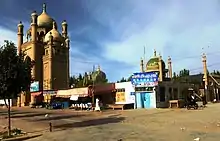
In 2004, an official who declined to be identified from the Lop county religious affairs committee told Radio Free Asia that fasting was not allowed during Ramadan, and that high school students in his town would be given candy before they left school at 4:30 p.m.. The official confirmed reports that Chinese authorities were continuing a program of heavy religious control and censorship.[30]
On July 11, 2006, the townships of Jiya and Yurungqash (Yulongkashi), then part of Lop County, were transferred to Hotan City.[2][31]
According to the World Uyghur Congress, in the lead-up to the 2008 Beijing Olympics, authorities in Lop county forced women to remove head coverings in a stated effort to promote "women for the new era".[32]
On October 21, 2014, Sampul township was re-designated as a town.[2][26]
At 9 PM on May 11 and 8:15 AM on May 12, 2015, two suicide bombings at a security checkpoint station in the county resulted in six deaths and four injured.[33][34]
On November 20, 2016, Hanggiya (Hanggui) was changed from a township into a town.[35]
Marriages between Uyghurs and Han Chinese persons are encouraged with subsidies by the government. In October 2017, the marriage of a Han Chinese man from Henan Province to a Uyghur woman from the county was celebrated on the county's social media page.[36]
Hetian Haolin Hair Accessories, a company first registered at the Lop County Beijing Industrial Park (洛浦县北京工业园区) in 2018, employed 5,000 new workers in its first year of business, making 159 international shipments. The Lop County Beijing Industrial Park has been associated with re-education camp photographs.[37]
According to The Guardian, as of early 2019, there were eight internment camps, officially labelled "vocational training centres", in the county.[5]
To increase aid delivery to Xinjiang, places in Xinjiang are paired with other areas of China which can provide aid. Tianjin and Hotan are paired in this program. In July 2019, football equipment and training materials with pictures and videos to local youth players and football coaches were provided for primary school students in the county.[38]
On September 14, 2020, the U.S. Department of Homeland Security blocked imports of products from four entities in Xinjiang including all products made with labor from the Lop County No. 4 Vocational Skills Education and Training Center and hair products made in the Lop County Hair Product Industrial Park.[6][39]
Geography
The northern part of Lop County is made up of sand dunes and ends in a straight line drawn in the Taklamakan Desert that forms part of the boundary between Hotan Prefecture and Aksu Prefecture. The Hotan River forms the boundary with Karakax County. The National Closed Sandified Land Protected Area is located in Northern Hanggiya Township.
The towns and townships are clustered around the oases around the highways in the southern part of the county.
The southern tip of the county reaches the Kunlun Mountains. At 5,466 m (17,933 ft) above sea level, the highest point in the county is Tekiliktag[40] (Tiekelekeshan, T'ieh-k'o-li-k'o Shan; تەكىلىكتاغ[41] / 铁克勒克山).[1]
 Map of the region including Lop (Lo-p'u) (DMA, 1983)
Map of the region including Lop (Lo-p'u) (DMA, 1983) Map including Lop (labeled as LO-P'U (LOP BAZAR)) and surrounding region (USATC, 1971)[lower-alpha 2]
Map including Lop (labeled as LO-P'U (LOP BAZAR)) and surrounding region (USATC, 1971)[lower-alpha 2]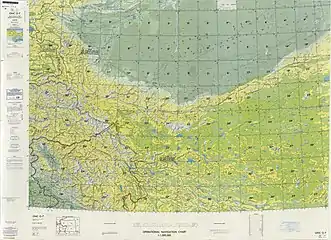 Map including Lop (labeled as LOP (LO-P'U)) and surrounding region (DMA, 1980)[lower-alpha 3]
Map including Lop (labeled as LOP (LO-P'U)) and surrounding region (DMA, 1980)[lower-alpha 3]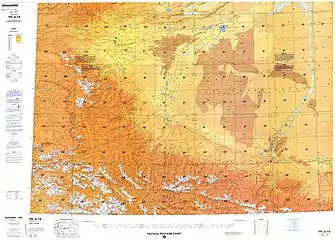 Map including Lop (labeled as Lop (Lo-p'u)) (DMA, 1984)[lower-alpha 4]
Map including Lop (labeled as Lop (Lo-p'u)) (DMA, 1984)[lower-alpha 4]
Climate
| Climate data for Lop (1991–2020 normals, extremes 1981–2010) | |||||||||||||
|---|---|---|---|---|---|---|---|---|---|---|---|---|---|
| Month | Jan | Feb | Mar | Apr | May | Jun | Jul | Aug | Sep | Oct | Nov | Dec | Year |
| Record high °C (°F) | 21.4 (70.5) |
22.9 (73.2) |
31.1 (88.0) |
36.0 (96.8) |
37.2 (99.0) |
40.5 (104.9) |
40.5 (104.9) |
39.3 (102.7) |
35.8 (96.4) |
31.0 (87.8) |
25.0 (77.0) |
18.6 (65.5) |
40.5 (104.9) |
| Average high °C (°F) | 1.7 (35.1) |
7.8 (46.0) |
17.2 (63.0) |
24.6 (76.3) |
28.4 (83.1) |
31.4 (88.5) |
32.8 (91.0) |
31.5 (88.7) |
27.8 (82.0) |
21.6 (70.9) |
12.7 (54.9) |
3.8 (38.8) |
20.1 (68.2) |
| Daily mean °C (°F) | −4.7 (23.5) |
1.1 (34.0) |
9.8 (49.6) |
16.6 (61.9) |
20.5 (68.9) |
23.7 (74.7) |
25.0 (77.0) |
23.6 (74.5) |
19.3 (66.7) |
11.9 (53.4) |
4.2 (39.6) |
−2.6 (27.3) |
12.4 (54.3) |
| Average low °C (°F) | −10.1 (13.8) |
−4.9 (23.2) |
2.8 (37.0) |
9.1 (48.4) |
13.2 (55.8) |
16.8 (62.2) |
18.5 (65.3) |
17.1 (62.8) |
12.0 (53.6) |
3.9 (39.0) |
−2.5 (27.5) |
−7.6 (18.3) |
5.7 (42.2) |
| Record low °C (°F) | −23.9 (−11.0) |
−23.3 (−9.9) |
−8.4 (16.9) |
−0.2 (31.6) |
2.8 (37.0) |
7.9 (46.2) |
10.2 (50.4) |
7.2 (45.0) |
2.6 (36.7) |
−4.7 (23.5) |
−11.5 (11.3) |
−20.1 (−4.2) |
−23.9 (−11.0) |
| Average precipitation mm (inches) | 1.6 (0.06) |
2.1 (0.08) |
3.3 (0.13) |
3.5 (0.14) |
7.1 (0.28) |
8.9 (0.35) |
8.1 (0.32) |
6.1 (0.24) |
4.3 (0.17) |
0.8 (0.03) |
0.9 (0.04) |
1.0 (0.04) |
47.7 (1.88) |
| Average precipitation days (≥ 0.1 mm) | 2.2 | 1.3 | 0.8 | 1.4 | 2.1 | 3.7 | 3.0 | 2.5 | 1.3 | 0.3 | 0.4 | 1.5 | 20.5 |
| Average snowy days | 5.2 | 2.7 | 0.6 | 0 | 0 | 0 | 0 | 0 | 0 | 0 | 0.6 | 3.6 | 12.7 |
| Average relative humidity (%) | 58 | 48 | 35 | 35 | 42 | 46 | 52 | 57 | 57 | 54 | 52 | 59 | 50 |
| Mean monthly sunshine hours | 168.0 | 170.0 | 188.5 | 206.8 | 244.5 | 249.2 | 235.8 | 219.8 | 232.8 | 263.0 | 216.5 | 180.8 | 2,575.7 |
| Percent possible sunshine | 54 | 55 | 50 | 52 | 55 | 57 | 53 | 53 | 64 | 77 | 72 | 61 | 59 |
| Source: China Meteorological Administration[42][43] | |||||||||||||
Administrative divisions
The county includes 1 subdistrict, 4 towns, 5 townships, and 1 other area:[2][26][44]
| Name | Simplified Chinese | Hanyu Pinyin | Uyghur (UEY) | Uyghur Latin (ULY) | Administrative division code | Notes | |
|---|---|---|---|---|---|---|---|
| Subdistrict | |||||||
| Chengqu Subdistrict | 城区街道 | Chéngqū Jiēdào | شەھەر رايونى كوچا باشقارمىسى | sheher rayoni kocha bashqarmisi | 653224001 | ||
| Towns | |||||||
| Lop Town[8] | 洛浦镇 | Luòpǔ Zhèn | لوپ بازىرى | lop baziri | 653224100 | ||
| Sampul Town[45][46] | 山普鲁镇 | Shānpǔlǔ Zhèn | سامپۇل بازىرى | sampul baziri | 653224101 | formerly Sampul Township (山普鲁乡) | |
| Hanggiya Town[46] | 杭桂镇 | Hángguì Zhèn | ھاڭگىيا بازىرى | hanggiya baziri | 653224102 | formerly Hanggiya Township (杭桂乡) | |
| Charbagh Town[47] | 恰尔巴格镇 | Qià'ěrbāgé Zhèn | چارباغ بازىرى | charbagh baziri | 653224103 | formerly Charbagh Township (چارباغ يېزىسى / 恰尔巴格乡) | |
| Townships | |||||||
| Buya Township | 布亚乡 | Bùyǎ Xiāng | بۇيا يېزىسى | buya yëzisi | 653224201 | ||
| Dol Township[48][46] | 多鲁乡 | Duōlǔ Xiāng | دول يېزىسى[49] | dol yëzisi | 653224205 | ||
| Nawa Township[50] | 纳瓦乡 | Nàwǎ Xiāng | ناۋا يېزىسى[51] | nawa yëzisi | 653224206 | ||
| Beshtoghraq Township | 拜什托格拉克乡 | Bàishítuōgélākè Xiāng | بەشتوغراق يېزىسى | beshtoghraq yëzisi | 653224207 | ||
| Aqqik Township[52] | 阿其克乡 | Āqíkè Xiāng | ئاچچىق يېزىسى[53] | Achchiq yëzisi | 653224208 | ||
Other:
- Lop County Beijing Industrial Park (洛浦县北京工业园区)
Economy
The county is known for its silk and carpets. The county's economy is primarily agricultural, producing cotton, wheat, corn and silkworm cocoons. Industries in the county include tractor repair, concrete, carpets, and silk reeling.[3]
As of 1885, there was about 44,300 acres (293,944 mu) of cultivated land in Lop.[54]
Demographics
| Year | Pop. | ±% p.a. |
|---|---|---|
| 2000 | 235,716 | — |
| 2010 | 232,916 | −0.12% |
| [2] | ||
According to the 2002 census, it had a population of 240,000.
At the end of 2008, 98% of the population of Lop County was Uyghur and 1.9% of the population was Han Chinese.[2]
As of 2015, 282,513 of the 287,590 residents of the county were Uyghur, 4,895 were Han Chinese and 182 were from other ethnic groups.[55]
As of the 2010s, the population of the county, reported as 280,000 by The Guardian, was almost entirely Uyghur.[5]
As of 1999, 98.6% of the population of Lop (Luopu) County was Uyghur and 1.36% of the population was Han Chinese.[56]
In 1952, the population of Lop was 123,608.[57]
Transportation
- China National Highway 217 through the Taklamakan Desert to northern Xinjiang
- China National Highway 315 between Hotan and Qira County
- G3012 Turpan–Hotan Expressway
Notes
- From historical accounts it is known that Alexander the Great, who married a Sogdian woman from Bactria named Roxana,[19][20][21] encouraged his soldiers and generals to marry local women; consequentially the later kings of the Seleucid Empire and Greco-Bactrian Kingdom had a mixed Persian-Greek ethnic background.[22][23][24]
Lucas Christopoulos writes : "The kings (or soldiers) of the Sampul cemetery came from various origins, composing as they did a homogeneous army made of Hellenized Persians, western Scythians, or Sacae Iranians from their mother's side, just as were most of the second generation of Greeks colonists living in the Seleucid Empire. Most of the soldiers of Alexander the Great who stayed in Persia, India and central Asia had married local women, thus their leading generals were mostly Greeks from their father's side or had Greco-Macedonian grandfathers. Antiochos had a Persian mother, and all the later Indo-Greeks or Greco-Bactrians were revered in the population as locals, as they used both Greek and Bactrian scripts on their coins and worshipped the local gods. The DNA testing of the Sampul cemetery shows that the occupants had maternal origins in the eastern part of the Mediterranean".[18]
- Locals in Xinjiang frequently observe UTC+6 (Xinjiang Time), 2 hours behind Beijing.
- From map: "DELINEATION OF INTERNATIONAL BOUNDARIES MUST NOT BE CONSIDERED AUTHORITATIVE".
- From map: "The representation of international boundaries is not necessarily authoritative."
- From map: "The representation of international boundaries is not necessarily authoritative"
References
- 政府概况. Luopu County Government Network 洛浦县政府网 (in Simplified Chinese). Retrieved 18 December 2019.
西以玉龙喀什河为界与和田县、和田市隔河相望,北伸延入塔克拉玛干大沙漠与阿克苏市、阿瓦提县为邻{...}总面积14287平方公里。{...}境内山丘属昆仑支脉,南部最高山为铁克勒克山,海拔5466米。
- 洛浦县历史沿革 [Lop County Historical Development] (in Simplified Chinese). XZQH.org. 2 December 2014. Retrieved 17 December 2019.
光绪二十八年(1902年8月),析和阗东境玉河以东十五庄,于阗西境乙根兰杆以西二十三庄置洛浦县(《新疆图志·建置一》),仍属和阗直隶州,下设三普拉、阿提良、塔瓦克等三明(大庄)。{...}2000年第五次人口普查,洛浦县常住总人口235716人,{...}2003年,全县总面积14314平方千米,{...}2006年,将洛浦县吉亚乡、玉龙喀什镇划归和田市管辖。2008年末,洛浦县总人口62097户235785人,其中维吾尔族占98%,汉族占1.9%。{...}2010年第六次人口普查,洛浦县常住总人口232916人,其中:城区街道19649人,洛浦镇18127人,布牙乡30257人,山普拉乡29509人,恰尔巴格乡41710人,杭桂乡40496人,多鲁乡32399人,纳瓦乡12961人,拜什托拉格乡6119人,阿其克管理区1486人,良种场203人。 2010年5月25日,自治区政府(新政函[2010]98号)同意设立阿其克乡(前身为阿其克管理区)。2014年10月21日,自治区政府(新政函[2014]192号)同意撤销山普鲁乡,设立山普鲁镇。调整后,全县辖2个镇、7个乡:洛浦镇、山普鲁镇、布亚乡、恰尔巴格乡、杭桂乡、多鲁乡、纳瓦乡、拜什托格拉克乡、阿其克乡。
- 夏征农; 陈至立, eds. (September 2009). 辞海:第六版彩图本 [Cihai (Sixth Edition in Color)] (in Chinese). 上海. Shanghai: 上海辞书出版社. Shanghai Lexicographical Publishing House. p. 1490. ISBN 9787532628599.
昆仑山北麓、玉龙喀什河沿岸。{...}面积1.43万平方千米。{...}1902年(清光绪二十八年)设县。经济以农业为主,产棉花、小麦、玉米和蚕茧。工业有农机修造、水泥、地毯、缫丝等。以产丝绸、地毯著名。
- Xinjiang: Prefectures, Cities, Districts and Counties
- Lily Kuo (11 January 2019). "'If you enter a camp, you never come out': inside China's war on Islam". The Guardian. Retrieved 16 December 2019.
Luopu, a sparsely populated rural county of about 280,000 that is almost entirely Uighur, is home to eight internment camps officially labelled "vocational training centres", according to public budget documents seen by the Guardian.
- "DHS Cracks Down on Goods Produced by China's State-Sponsored Forced Labor". Department of Homeland Security. 14 September 2020. Retrieved 19 September 2020.
- Lop (Approved - N) at GEOnet Names Server, United States National Geospatial-Intelligence Agency
- Complete Atlas Of The World (3 ed.). Penguin Random House. 2016. p. 238. ISBN 978-1-4654-4401-1 – via Internet Archive.
Lop
- Che Muqi [in Chinese] (1989). The Silk Road, Past and Present. Beijing: Foreign Languages Press. p. 286. ISBN 0-8351-2100-3 – via Internet Archive.
Today in Hotan Prefecture, including Pishan, Moyu, Lop, Qira, Yutian and Minfeng counties–places under the jurisdiction of ancient Khotan State which once dominated the southern route of the Silk Road–818 cobbled canals with a combined length of 1,500 kilometres have been built.
- Jianghua Zhang; Xianhui Zhou; Qiang Xing; Yaodong Li; Ling Zhang; Qina Zhou; Yanmei Lu; Yinwen Fan; Abu Lizi; Wenhong Yan; Hongyan Wang; Meiling Zhai; Jianfu Bao; Liping Chen; Maihe Tuoti; Haidong Cui; Jian Wang; Baopeng Tang (28 January 2019). "Epidemiological investigation of sudden cardiac death in multiethnic Xinjiang Uyghur autonomous region in Northwest China". BMC Public Health. 19 (1): 116. doi:10.1186/s12889-019-6435-8. PMC 6348672. PMID 30691418.
Thus, 11 survey sites were finally selected, as follows: the Saybagh District of Ürümqi city; in Ili Prefecture, Yining city and Xinyuan County; within Bayingolin Prefecture, Korla city and Yanqi County; in Hami Prefecture, Hami city and Barkol County; within the Hotan Prefecture, Hotan city and Lop County; and of the Bingtuan, the cities of Aral and Wujiaqu.
- Lop. Columbia Lippincott Gazetteer of the World. Morningside Heights, New York, Columbia University Press, by arrangement with J.B. Lippincott Co. 1952. p. 1081 – via Internet Archive.
Lop (lōp)
- "洛浦县政府网 Luopu County Government Network" (in Simplified Chinese and English). Retrieved 18 December 2019.
- Luopu (Approved - N) at GEOnet Names Server, United States National Geospatial-Intelligence Agency
- Chengzhi, Xie; Chunxiang, Li; Yinqiu, Cui; Dawei, Cai; Haijing, Wang; Hong, Zhu; Hui, Zhou (2007). "Mitochondrial DNA analysis of ancient Sampula population in Xinjiang". Progress in Natural Science. 17 (8): 927–933. doi:10.1080/10002007088537493.
- Christopoulos, Lucas (August 2012), "Hellenes and Romans in Ancient China (240 BC – 1398 AD)," in Victor H. Mair (ed), Sino-Platonic Papers, No. 230, Chinese Academy of Social Sciences, University of Pennsylvania Department of East Asian Languages and Civilizations, pp 15-16, ISSN 2157-9687.
- Christopoulos, Lucas (August 2012), "Hellenes and Romans in Ancient China (240 BC – 1398 AD)," in Victor H. Mair (ed), Sino-Platonic Papers, No. 230, Chinese Academy of Social Sciences, University of Pennsylvania Department of East Asian Languages and Civilizations, p. 27, ISSN 2157-9687.
- Trading Genes along the Silk Road: mtDNA Sequences and the Origin of Central Asian Populations; David Comas1, 2, *, Francesc Calafell1, 3, *, Eva Mateu1, Anna Pérez-Lezaun1, 4, Elena Bosch1, Rosa Martínez-Arias1, Jordi Clarimon1, Fiorenzo Facchini5, Giovanni Fiori5, Donata Luiselli5, Davide Pettener5 and Jaume Bertranpetit1, The American Journal of Human Genetics, Volume 63, Issue 6, 1824–1838, 1 December 1998 doi:10.1086/302133
- Christopoulos, Lucas (August 2012), "Hellenes and Romans in Ancient China (240 BC – 1398 AD)," in Victor H. Mair (ed), Sino-Platonic Papers, No. 230, Chinese Academy of Social Sciences, University of Pennsylvania Department of East Asian Languages and Civilizations, p. 27 & footnote #46, ISSN 2157-9687.
- Livius.org. "Roxane." Articles on Ancient History. Page last modified 17 August 2015. Retrieved on 8 September 2016.
- Strachan, Edward and Roy Bolton (2008), Russia and Europe in the Nineteenth Century, London: Sphinx Fine Art, p. 87, ISBN 978-1-907200-02-1.
- For another publication calling her "Sogdian", see Christopoulos, Lucas (August 2012), "Hellenes and Romans in Ancient China (240 BC – 1398 AD)," in Victor H. Mair (ed), Sino-Platonic Papers, No. 230, Chinese Academy of Social Sciences, University of Pennsylvania Department of East Asian Languages and Civilizations, p. 4, ISSN 2157-9687.
- Holt, Frank L. (1989), Alexander the Great and Bactria: the Formation of a Greek Frontier in Central Asia, Leiden, New York, Copenhagen, Cologne: E. J. Brill, pp 67–8, ISBN 90-04-08612-9.
- Ahmed, S. Z. (2004), Chaghatai: the Fabulous Cities and People of the Silk Road, West Conshokoken: Infinity Publishing, p. 61.
- Magill, Frank N. et al. (1998), The Ancient World: Dictionary of World Biography, Volume 1, Pasadena, Chicago, London,: Fitzroy Dearborn Publishers, Salem Press, p. 1010, ISBN 0-89356-313-7.
- Stein, M. Aurel (1907). Ancient Khotan: Detailed report of archaeological explorations in Eastern Turkestan. Clarendon Press. p. 482ff.
- 洛浦县县域简介. Luopu County Government Network 洛浦县政府网 (in Simplified Chinese). 13 December 2019. Retrieved 18 December 2019.
清光绪二十八年(1902年8月),设置洛浦县。{...}2010年5月25日,自治区政府(新政函[2010]98号)同意设立阿其克乡(前身为阿其克管理区)。2014年10月21日,自治区政府(新政函[2014]192号)同意撤销山普鲁乡,设立山普鲁镇。调整后,全县辖2个镇、7个乡:洛浦镇、山普鲁镇、布亚乡、恰尔巴格乡、杭桂乡、多鲁乡、纳瓦乡、拜什托格拉克乡、阿其克乡。
- Michael Dillon (2004). Xinjiang: China's Muslim Far Northwest. London and New York: RoutledgeCurzon. p. 55. ISBN 9781134360956 – via Google Books.
- MAJ J.Scott LaRonde (22 May 2008). "Protracted Counterinsurgency: Chinese COIN Strategy in Xinjiang". p. 41. Retrieved 19 December 2019 – via Internet Archive.
- Wang Mingyi (22 March 1988). "Science & Technology China". Foreign Broadcast Information Service. p. 25. Retrieved 19 December 2019 – via Internet Archive.
- "THE INTERNET IN CHINA: ATOOL FOR FREEDOM OR SUPPRESSION?". Committee on International Relations, US House of Representatives. 15 February 2006. p. 186 – via Internet Archive.
- 和田市历史沿革 [Hotan City Historical Development] (in Simplified Chinese). XZQH.org. 2 December 2014. Retrieved 20 December 2019.
2006年7月11日,洛浦县吉亚乡、玉龙喀什镇与和田县吐沙拉乡正式划归和田市管辖。
- "Authorities Increase Repression in Xinjiang in Lead-up to and During Olympics". Congressional-Executive Commission on China. 25 November 2008. Retrieved 19 December 2019.
Authorities in Lop county, Hoten district, have been forcing women to remove head coverings in a stated effort to promote "women for the new era" according to the World Uyghur Congress, as cited in an August 27 report from RFA.
{{cite web}}: External link in|quote= - Roseanne Gerin, Shohret Hoshur (13 May 2015). "Six Dead, Four Injured in Two Successive Suicide Attacks in China's Xinjiang". Radio Free Asia. Translated by Shohret Hoshur. Retrieved 18 December 2019.
Two successive suicide bombing attacks have killed six people and injured four others at a security checkpoint station in northwestern China's restive Xinjiang region, according to area police officials. The attacks in Hotan (in Chinese, Hetian) prefecture's Lop (Luopu) county, occurred at 9 p.m. on Monday and 8:15 a.m. on tuesday, killing three suicide attackers and three police officers and wounding four other policemen, said Osman Toxtixelil, the police chief of the Konabazar (Old Town) police station in Lop town. No bystanders were killed or injured in the attacks, he told RFA's Uyghur Service.
- Joshua Lipes, Eset Sulaiman (28 May 2015). "Chinese Police Shoot Two Uyghurs Dead in Xinjiang Bomb Attack". Radio Free Asia. Translated by Eset Sulaiman. Retrieved 17 December 2019.
Hotan prefecture in southwestern Xinjiang has been a hotbed of violent stabbing and shooting incidents between ethnic Uyghurs and Chinese security forces, with attacks coming amid a string of assaults and bombings across the region. Two successive suicide bombings on May 11 and 12 at a security checkpoint station in Hotan's Lop (Luopu) county killed three attackers and three police officers, and wounded four other policemen, according to local authorities, who said the incidents were likely "politically motivated."
- 关于同意洛浦县杭桂乡撤乡设镇的批复(新政函[2016]292). 新疆民政 (in Simplified Chinese). 5 December 2016. Archived from the original on 16 August 2018. Retrieved 19 December 2019 – via Internet Archive.
2016年11月20日,自治区人民政府同意撤销洛浦县杭桂乡建制,设立杭桂镇,其行政区域界线、政府驻地及隶属关系不变。
- Dake Kang; Yanan Wang (1 December 2018). "China's Uighurs told to share beds, meals with party members". Associated Press. Retrieved 18 December 2019.
In recent years, the government has even encouraged Uighurs and Han Chinese to tie the knot. Starting in 2014, Han-Uighur spouses in one county were eligible to receive 10,000 yuan ($1,442) annually for up to five years following the registration of their marriage license. Such marriages are highly publicized. The party committee in Luopu county celebrated the marriage of a Uighur woman and a "young lad" from Henan in an official social media account in October 2017. The man, Wang Linkai, had been recruited through a program that brought university graduates to work in the southern Xinjiang city of Hotan. "They will let ethnic unity forever bloom in their hearts," the party committee's post said. "Let ethnic unity become one's own flesh and blood."
- Juozapas Bagdonas (16 November 2019). "Tracking Down the Fruits of Xinjiang's Forced Labor Industry". The Diplomat. Retrieved 17 December 2019.
Hetian Haolin Hair Accessories was registered in the Beijing Industrial Park in Hotan's Lop county on January 19, 2018. A re-education camp in the same compound was identified by Radio Free Asia as the location of the famous picture showing hundreds of detainees listening to a de-radicalization speech. According to Haolin's spokesman, the company has already employed 5,000 new workers in its first year of business – more than 2 percent of the entire county's population. Data from ImportGenius shows that the company has made a total of 159 international shipments, which first went through ports in Vietnam and on to buyers from four U.S. cities. All of these companies belong to an entity called I&I Hair Corporation with headquarters in Newcastle, Georgia. With the last shipment having taken place on October 28, possibly more than a thousand tons of synthetic hair products made by detainees in Lop county have been ordered by the American company. I&I Hair runs a brand called "Oh Yes Hair" with a wide selection of braids and other hair products advertised on its Facebook page.
- Shi Yinglun, ed. (8 July 2019). "Tianjin helping Xinjiang's football development in China". Xinhua News Agency. Archived from the original on July 8, 2019. Retrieved 16 December 2019.
Tianjin, paired with Hetian city, provided football equipment and training materials with pictures and videos to local youth players and football coaches this month. Two professional football coaches from Tianjin also guided students' training sessions. Lgamberdi, a football coach in a primary school of Luopu County, said though the equipment and coaches were limited, students still showed great enthusiasm in playing football. "With this new equipment, we will strive to perform better in competitions and cultivate more footballing talents," Lgamberdi said.
- Albert, Eleanor. "Citing Forced Labor Concerns, US Issues Ban on Xinjiang Cotton". thediplomat.com. The Diplomat. Retrieved 4 December 2020.
- Tekiliktag (Approved - N) at GEOnet Names Server, United States National Geospatial-Intelligence Agency
- تەكىلىكتاغ (Variant Non-Roman Script - VS) at GEOnet Names Server, United States National Geospatial-Intelligence Agency
- 中国气象数据网 – WeatherBk Data (in Simplified Chinese). China Meteorological Administration. Retrieved 10 October 2023.
- 中国气象数据网 (in Simplified Chinese). China Meteorological Administration. Retrieved 10 October 2023.
- 2018年统计用区划代码和城乡划分代码:洛浦县 [2018 Statistical Area Numbers and Rural-Urban Area Numbers: Lop County] (in Simplified Chinese). National Bureau of Statistics of the People's Republic of China. 2018. Retrieved 17 December 2019.
统计用区划代码 名称 653224001000 城区街道办事处 653224100000 洛浦镇 653224101000 山普鲁镇 653224102000 杭桂镇 653224201000 布亚乡 653224203000 恰尔巴格乡 653224205000 多鲁乡 653224206000 纳瓦乡 653224207000 拜什托格拉克乡 653224208000 阿其克乡 653224401000 良种场 653224402000 洛浦县北京农业科技示范园区 653224403000 洛浦县北京工业园区
- Sampul (Approved - N) at GEOnet Names Server, United States National Geospatial-Intelligence Agency
- Xie Yuzhong (2003). 地名中的新疆 (in Simplified Chinese). Ürümqi: 新疆人民出版社. p. 252. ISBN 7-228-08004-1.
杭桂 Hanggiya {...}
}
多鲁 Dol {...}
山普鲁 Sampul {... - huaxia, ed. (17 September 2020). "Full Text: Employment and Labor Rights in Xinjiang". Xinhua News Agency. Retrieved 20 September 2020.
For example, a villager named Arapat Ahmatjan from Charbagh Township, Lop County, Hotan Prefecture
- Dol (Approved - N) at GEOnet Names Server, United States National Geospatial-Intelligence Agency
- دول (Variant Non-Roman Script - VS) at GEOnet Names Server, United States National Geospatial-Intelligence Agency
- Nawa (Approved - N) at GEOnet Names Server, United States National Geospatial-Intelligence Agency
- ناۋا (Variant Non-Roman Script - VS) at GEOnet Names Server, United States National Geospatial-Intelligence Agency
- Aqqik (Approved - N) at GEOnet Names Server, United States National Geospatial-Intelligence Agency
- ئاچچىق (Variant Non-Roman Script - VS) at GEOnet Names Server, United States National Geospatial-Intelligence Agency
- Herold J. Wiens (November 1966). "Cultivation Development and Expansion in China's Colonial Realm in Central Asia". The Journal of Asian Studies. 26 (1): 75. doi:10.2307/2051832. JSTOR 2051832. S2CID 162339064.
- 3-7 各地、州、市、县(市)分民族人口数 (in Chinese (China)). Xinjiang Uyghur Autonomous Region Bureau of Statistics. Archived from the original on 2017-10-11. Retrieved 2017-09-03.
- Morris Rossabi, ed. (2004). Governing China's Multiethnic Frontiers (PDF). University of Washington Press. p. 180. ISBN 0-295-98390-6.
- Leon E. Seltzer, ed. (1952). The Columbia Lippincott Gazetteer of the World. Columbia University Press. p. 1081 – via Internet Archive.